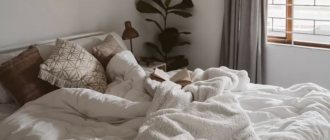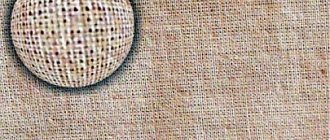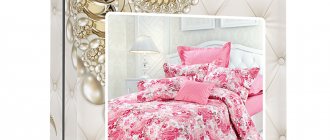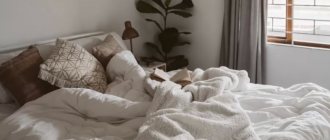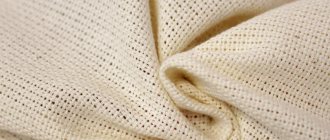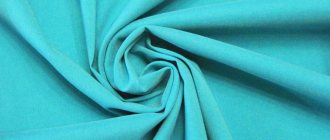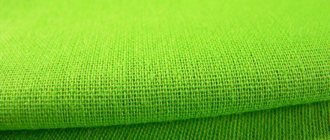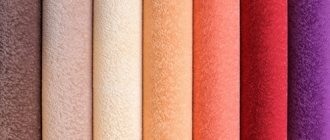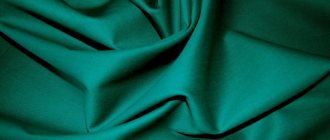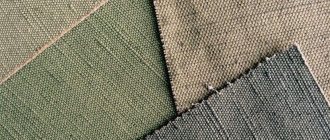What kind of calico fabric?
What is calico?
Calico is a plain weave cotton fabric. Its surface is smooth and matte, the texture on both sides is the same. This is a fairly light fabric (density on average 90-150 grams per square meter), unpretentious to work with, hygienic, and easy to care for.
It is believed that the name “calico” comes from the Turkic or Arabic beyaz - white, bleached. Calico was brought to Rus' from Asia back in the 16th century, and its production in our country began two centuries later. At first, this fabric was used for lining, for example, kaftans and outerwear, and for sewing simple underwear. Since then, the range of use of calico has greatly expanded: now it is used to sew home textiles and clothing.
We are accustomed to the fact that calico is 100 percent cotton. But today this fabric produced, for example, in China or Pakistan can contain up to 15% polyester fibers. If this is a fundamental point, you should pay attention to it when purchasing.
What kind of fabric is matting?
Calico: basic properties
When talking about the properties of calico, we will keep in mind classic 100% cotton fabric. Its main properties:
* Ease of use: calico frays little, is easy to cut and sew.
* Easy to care for: calico washes well and dries quickly.
* Hygiene: this material is highly breathable, hygroscopic, hypoallergenic.
* Not electrified.
* Wear resistance: calico is quite durable and does not fade for a long time.
* At the same time, calico, when used for a long time and after many washes, can peel (pellets form on it).
The undoubted advantage of calico is its low price.
What kind of fabric is percale?
What kind of calico is there and what is sewn from it?
Calico can be divided into four groups according to density and coloring:
* Severe
The densest type, unbleached and undyed fabric, having a light beige, light beige-gray, milky tint. Severe calico is used for upholstery of internal furniture elements and sewing workwear.
* Bleached
This calico is a little softer than harsh calico and is used to make bedding and other home textiles.
* Plain painted
In terms of density and structure, smoothly dyed calico is similar to bleached calico, but is painted in various solid colors. This material is used to make bed and table linen, linings for coats and suits, and sometimes clothes.
* Printed
Calico with a printed pattern. They sew bed linen, children's and adult clothes from it, make tablecloths, napkins, and towels.
Of course, everyone who sews knows that calico is used for sewing clothing models. A mockup or sample is, one might say, a draft of a product. It is sewn before the main product to evaluate the fit, refine the pattern, and so on. When choosing fabric for a model, you should take calico that is close in density to the material of your item. You can even choose a similar color to better visualize the future model.
Plus, it is thin bleached calico that is good as a material for an ironing iron (this is a piece of fabric that protects the material and/or ironing board during ironing).
What is a product sample and why sew it
How to care for calico?
* Wash purchased fabric before use. New fabric may shrink a little, plus it will become softer after washing.
* Wash at 30-60 degrees, universal detergents are suitable. To preserve color, it is better to wash and dry items made from printed calico inside out.
* Machine dryable.
* In order for washed calico to iron better, it is better to iron it a little damp.
What kind of fabric is canvas?
What kind of fabric is drape?
Cupro - “copper” fabric for beautiful products
Photo: VipDukkani.com, EvHayat, Goblen, Alibaba
What can you sew from calico for a child?
A wonderful article on slingolig, I highly recommend reading it to those who are wondering: why does this sling cost so much, and this one so much? Who cares?
Link: https://www.slingoliga.ru/opyt/clingocennosti/
Or the full text, the authors of the article are listed at the end:
Most parents who set out to purchase a sling focus primarily on its cost. Not for the obvious softness, plasticity, ease of wearing and not for the mysterious “performance characteristics”, “pattern”, “handwoven”... Namely for the price. Why is this happening?
Often people are pushed to buy their first sling by circumstances that cannot tolerate delay. These circumstances vary, but in a nutshell they can be described as a “tame child.” In this case, the parent may not even be familiar with the types of slings and simply buy what the seller called this word in order to start wearing the baby as soon as possible. If the choice still falls on classic slings, and not on sling bags and kangaroos masquerading as them, then according to the “cheaper” criterion, a sling with rings (SSK) or a knitted sling scarf is often chosen. The second conditional category of parents are those who have more or less studied the theory of babywearing, but are not sure that they will be able to master the sling and will actively use it. In this case, the mother is afraid to spend a lot of money on an item that may lie in the closet. (It is typical that rarely anyone is embarrassed by the costs of cribs or strollers. Although during active babywearing, these seemingly integral household items are used less often than usual, or even not used at all.) However, both of them may wonder: Why does this “ordinary rag” cost so much? However, the opposite situation also occurs: in online communities for slings, it is not uncommon to think that “expensive slings forgive mistakes in winding,” i.e. Some parents sincerely believe that more expensive means better. Let's figure out what affects the price of a sling? 1. Fabric The fabric from which scarf slings are made, ring slings, May-slings and ergonomic backpacks are sewn must have a certain set of properties: for example, stretch diagonally, but not horizontally and vertically, be soft and pleasant to the skin, dyed with dyes safe for mother and child, does not fade when wet... Separately, it is worth mentioning the special “scarf” fabric : such fabric is woven to order in small batches, it is intended for a narrow circle of consumers, it is used only for sewing slings. The cost of scarf fabric is determined by the cost of its production (for example, double diagonal weaving is cheaper to produce than jacquard or diamond), production volume, and the cost of consumables. Adding other components to cotton thread (the term “blend” is used for this) - flax, silk, hemp, etc. - serves certain purposes. For example, linen provides greater load-bearing capacity when worn in hot weather; silk and bamboo provide thinness and delicacy of the fabric; wool and cashmere increase the warming properties of the sling. But even if we take one category of scarves - for example, diagonally woven cotton - then several other parameters also influence the price. Thus, the density and thickness of the threads from which the sling is woven is of great importance. The thicker the threads and the looser the weaving the manufacturer uses, the more flexible the fabric, the higher the quality of the sling, and the better it will fit the mother and child. Woven materials created for other purposes are conditionally suitable for the production of slings: their density is higher, the threads are thinner. This is not critical for a blanket, bag or hammock, but a sling made of such fabric will be tough, “oaky” and will require preliminary breaking in. The raw material - in our case cotton - can also be of different quality. The more expensive Egyptian one is more stable in wear, does not become covered with pills, and is not so sensitive to frequent washing. Uzbek cotton is cheaper, but may lack the mentioned advantages. Sometimes slings made from cheap, low-quality cotton can feel stiffer and unpleasant to the touch. Some manufacturers additionally process finished slings with steam or mechanically knead them - this makes them softer, but also increases the cost. Finally, the appearance of the sling, the creation of new patterns (“patterns”), and the development of color combinations also require expenses for the services of a designer. Knitted slings are sewn from a less specific fabric, which can be sold in regular stores and used for sewing other things and clothing. It is produced in large batches. Therefore, knitted scarves are usually cheaper than woven scarves of similar size. Sometimes scarf slings are made from any other fabric. The apparent savings are unlikely to justify themselves. For example, high-quality calico that can fit a child well and support his weight, given the high consumption (a sling scarf requires about 5 meters of fabric), will not cost much less than a ready-made woven scarf from the budget range. But at the same time, a calico sling will be much less comfortable to wear for both an adult and a child. In addition, it is almost impossible to sell it in the future on the secondary market. Of course, experienced babywearers can successfully use slings made even from cheap shirt fabric or budget linen. But such a sling requires more skill and care in winding and can, at the first failure, perpetuate in the beginner a negative attitude towards slings in general. For ring slings, the fabric is less critical; they are often made from calico or satin. This is a normal option, but compared to scarf ones, they are less wear-resistant and not as versatile.
2. Type of sling Slings of different types, sewn from the same fabric, may differ in price due to different material consumption and manufacturing costs. Thus, a sling with rings requires only 2-2.5 m of fabric. Therefore, when taking into account the cost of high-quality rings for it and the work of a seamstress, the SSK may be cheaper than a similar long sling-scarf, but more expensive than a short one. Despite its apparent compactness, a May-sling requires costs for cutting and sewing; it takes quite a lot of fabric, plus possible additional seals and accessories. Therefore, a May Sling can cost the same or even be more expensive than a similar long scarf. Ergonomic backpacks are made from both scarf and cheaper fabric, but they also require high-quality fittings, a belt seal and straps. Taking into account also the costs of cutting and sewing the product, a sling backpack may cost more than a long scarf sling or a similar sling. 3. Brand, country of manufacturer There are more and more manufacturers of slings in the world - there are no longer just a few of them, as at the dawn of babywearing, but dozens. There are reputable companies that have been delivering quality products for many years. There are new manufacturers, both Russian and foreign (Polish firms have become more active lately), who are just starting to weave and sew. Accordingly, their offers may vary significantly in price. Sometimes you can talk about some overpayment for a well-promoted brand, which is positioned in the mass consciousness as particularly high-quality and reliable. But, unfortunately, this is not always true and the popularity of a brand does not necessarily guarantee its advantages. It is important to remember: there is not a single manufacturer that constantly produces slings of the same quality. Everyone has their ups and downs, advantages and disadvantages. 4. Availability of certificates, procedure for import into the country Most of the slings on the Russian market are certified. To obtain such a certificate, the manufacturer must incur costs. Of course, a sling with documents will be more expensive than a similar one with unconfirmed quality. Slings that do not require the import of the products themselves or raw materials for their manufacture into Russia with the payment of customs duties will be cheaper than those of similar quality if their production is impossible without such expenses. This does not mean that all Russian slings are obviously cheaper than foreign ones: they can be made from imported raw materials. And on the contrary, the import of slings into Russia is not always accompanied by the payment of customs duties. 5. Exclusivity The diversity and saturation of the sling market with serial products has its downside: there are manufacturers and private craftsmen who are able to surprise the end consumer with the exclusivity of their products, batch limits, etc. An exclusive product can be especially expensive, like a practically one-of-a-kind collectible with a unique set of properties - perhaps these are hand-woven slings - or, conversely, unusually cheap when privately sewn from budget fabric.
From all of the above, we can conclude that the price of a sling is influenced by many factors. Therefore, the cost of the same type can vary greatly among different manufacturers or even among different series from the same manufacturer. An important indicator is the price/quality ratio, which can affect popularity. But according to this criterion, slings of different categories can be popular - from budget to elite. And the higher the price of the product, the more the buyer’s solvency influences the choice of a specific model. More expensive does not always mean better: each of us puts our own meaning into the concept of “better”. A good sling should only ensure the correct positioning of the baby on the parent’s body and the comfort of babywearing. Additionally, a sling can delight its owner with radiant beauty, have exclusive status, smell like caterpillars and roses, hug like a cloud... But so far, not a single sling in the world has an autopilot and auto-tuning. Whatever sling you choose, study the instructions, try the windings and carry your children with pleasure. And we, sling consultants, will help you with this. Elena Karavaeva, Ekaterina Sokoltseva. Photo by Elena Karavaeva.
Galaxy print made from Shuya calico (I love PHILIPS)
This master class illustrates how to make something more interesting from simple calico, intended for sewing bed linen.
Despite the fact that everyone is already tired of the galaxy print, I still remain a supporter of it. Inspired by the works of Christopher Kane, who actively exploited this pattern in his time, I decided to take aim at the beautiful. I started from this dress: The basis for the future product (it was decided to sew a skirt) was taken from a domestically produced calico purchased in one of the stores in St. Petersburg (the city of Shuya), which was modified. She looks much cuter in the photo than in reality.
To make a simple circle skirt, just above the knee, you needed:
- Calico with stars
- Lining fabric
- Soft mesh
- Fabric and adhesive for belt
- Concealed zipper and small button
- Foot for sewing a hidden zipper
- White
- Latex gloves
- Acrylic paints for fabric
- Brushes and sponges
- Hot-melt rhinestones
- Soldering iron for rhinestones (I don’t have one - I only had a regular 80-watt one)
- Measuring tape, scissors, thread
We first estimate the layout of the details of the cut of the product, so as not to paint the lunges in vain. We lay the fabric on a piece of polyethylene and twist the places where the orange stars are located into spiral buns like this:
This is necessary so that the whiteness does not turn the entire area into one large spot. Having previously protected your hands and respiratory organs, we begin to spray bleach using a spray bottle.
Next, thoroughly rinse the fabric and iron it while wet so that it gives the necessary shrinkage. After these manipulations, we get an image that has added color and depth. At the next stage we will use paints and brushes:
Lightly moisten the surface where the galaxy should appear with water. We apply lighter and purer shades closer to its center, and those that are darker - to the periphery. We darken some areas, adding contrast. We draw rays for stars and tails for comets. Let’s draw the characteristic “worms”—the boundaries of clouds of interstellar dust:
We iron it, fixing the dye and at the end we get fabric almost suitable for sewing clothes. “Almost” - because after using white and subsequent washing, the black pigment faded significantly, and the fabric began to look washed. It was decided to make a three-layer skirt - use a soft mesh over the main fabric and put it on a lining of plain black calico (which was already in the bins), because... the seamy side of the star-galactic fabric left much to be desired. There is no need to describe the cutting order and technological sequence of sewing a circle skirt, because similar ones have been seen many times on Second Street. I will only note that the zipper is located in the middle seam, and the upper section is finished with a belt:
And yet the skirt was somehow faded. It was decided to add rhinestones! I'm not a big fan of this type of finish, but when covered with mesh they give a very nice subdued shine. I didn’t choose colors - I stuck on what was lying around idle (white and blue). The lack of a specialized device for gluing glitter forced me to take up a soldering iron. Having placed the rhinestone on the fabric, gently press it with the tip of the soldering iron tip and wait 10-12 seconds (for 80 W) until the adhesive layer melts.
The skirt decor is complete. During the day it looks a little deliberate and even carnival-like, but for the evening it is quite suitable. In motion, it looks less orange and colorful - here the entire black background has been eaten up by the coattails.
In the near future we plan to make a sleeveless dress with an open back from the same fabric.
